Discover 35 hidden attractions, cool sights, and unusual things to do in Austin (United States). Don't miss out on these must-see attractions: Texas State Capitol, Blanton Museum of Art, and Texas State Cemetery. Also, be sure to include Heroes of the Alamo Monument in your itinerary.
Below, you can find the list of the most amazing places you should visit in Austin (Texas).
Table of Contents
Texas State Capitol
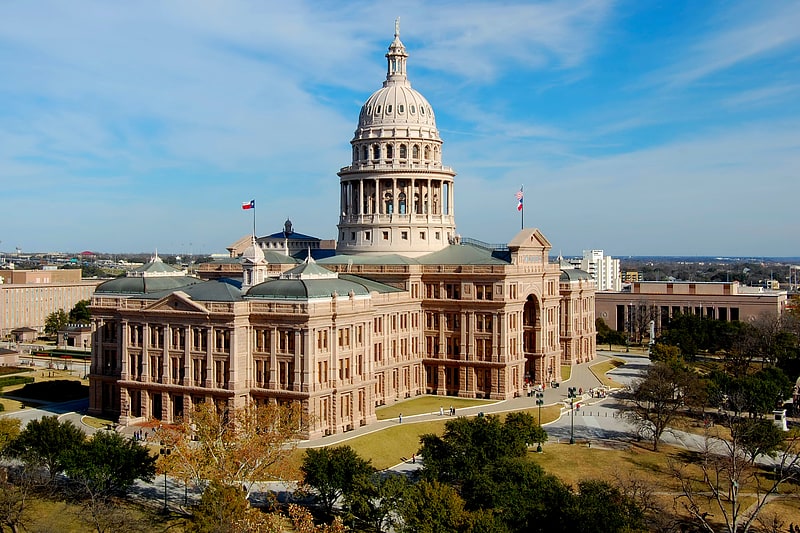
Home to the state legislature. The Texas State Capitol is the capitol and seat of government of the American state of Texas. Located in downtown Austin, Texas, the structure houses the offices and chambers of the Texas Legislature and of the Governor of Texas. Designed in 1881 by architect Elijah E. Myers, it was constructed from 1882 to 1888 under the direction of civil engineer Reuben Lindsay Walker. A $75 million underground extension was completed in 1993. The building was added to the National Register of Historic Places in 1970 and recognized as a National Historic Landmark in 1986.
The Texas State Capitol is 302.64 feet (92.24 m) tall, making it the sixth-tallest state capitol and one of several taller than the United States Capitol in Washington, D.C. The capitol was ranked 92nd in the 2007 "America's Favorite Architecture" poll commissioned by the American Institute of Architects.[1]
Address: 1100 Congress Ave, 78701 Austin (Central Austin)
Blanton Museum of Art
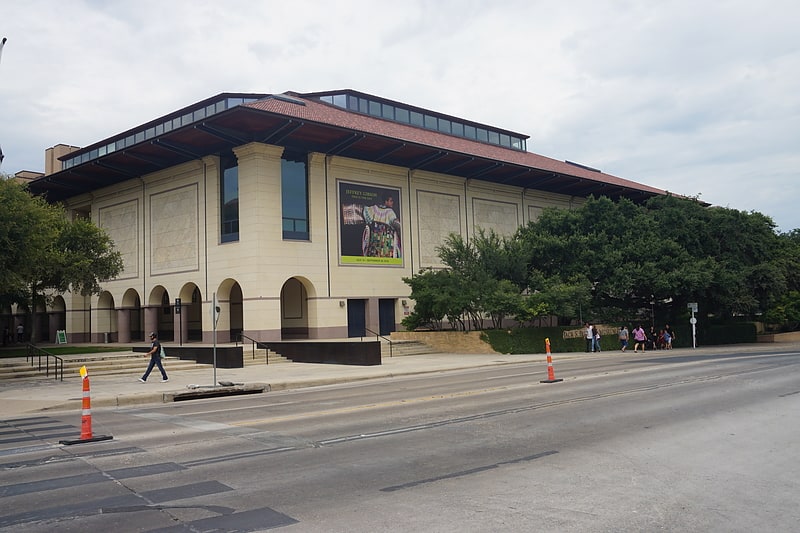
Museum in Austin, Texas. The Jack S. Blanton Museum of Art at the University of Texas at Austin is one of the largest university art museums in the U.S. with 189,340 square feet devoted to temporary exhibitions, permanent collection galleries, storage, administrative offices, classrooms, a print study room, an auditorium, shop, and cafe. The Blanton's permanent collection consists of more than 21,000 works, with significant holdings of modern and contemporary art, Latin American art, Old Master paintings, and prints and drawings from Europe, the United States, and Latin America.[2]
Address: 200 E Martin Luther King Jr Blvd, 78712 Austin (Central Austin)
Texas State Cemetery
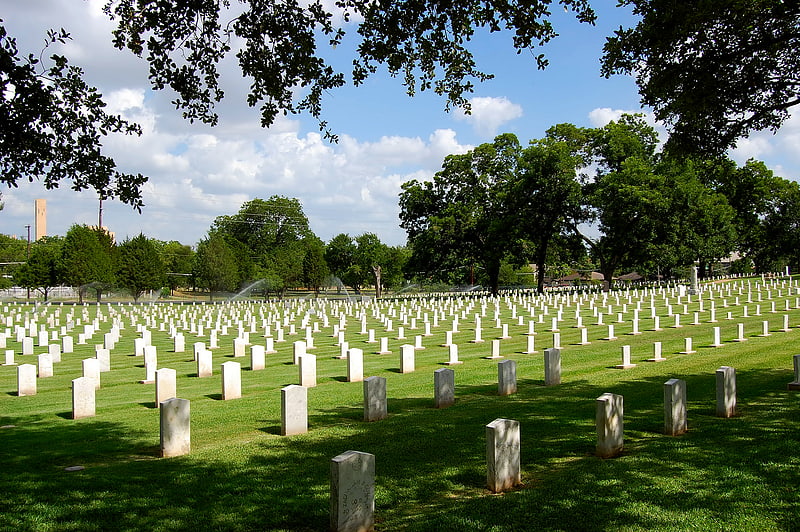
Cemetery in Austin, Texas. The Texas State Cemetery is a cemetery located on about 22 acres just east of downtown Austin, the capital of the U.S. state of Texas. Originally the burial place of Edward Burleson, Texas Revolutionary general and vice-president of the Republic of Texas, it was expanded into a Confederate cemetery during the Civil War. Later it was expanded again to include the graves and cenotaphs of prominent Texans and their spouses.
It is a popular tourist attraction and colloquially referred to as the "Arlington of Texas" because of the renown of those interred and proximity to the seat of government.
The cemetery is divided into two sections. The smaller one contains around 900 graves of prominent Texans, while the larger has over 2,000 marked graves of Confederate veterans and widows. There is room for 7,500 interments; the cemetery is about half full, after including plots chosen by people who are eligible for burial.[3]
Address: 909 Navasota St, 78702-3322 Austin (East Austin)
Heroes of the Alamo Monument
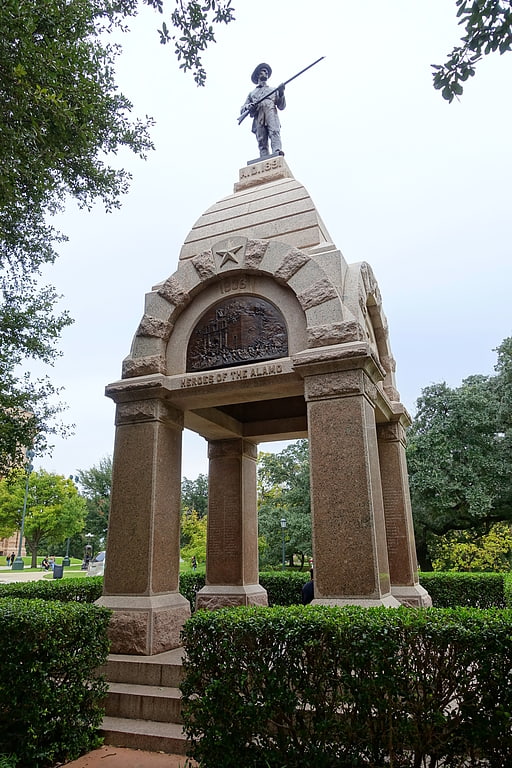
Historical landmark in Austin, Texas. The Heroes of the Alamo Monument is an outdoor memorial commemorating those who fought and died during the Battle of the Alamo, installed on the Texas State Capitol grounds, in Austin, Texas, United States. It was designed by J.S. Clark, sculpted by Crohl Smith, and erected in 1891. The monument features a Texas Sunset Red Granite base topped by a bronze statue of a Texan carrying a muzzle-loading rifle. Among the names inscribed in the base's supports are James Bowie, David Crockett, and William B. Travis.[4]
Circuit of the Americas

Sports facility in Travis County, Texas. Circuit of the Americas is a Grade 1 FIA-specification 5.514-kilometre motor racing track and facilities located within the extraterritorial jurisdiction of Austin, Texas in the United States. The facility is home to the Formula One United States Grand Prix, NASCAR's Texas Grand Prix, and the Grand Prix of the Americas, a round in MotoGP. It previously hosted the Australian V8 Supercars, the Americas Rallycross Championship, the American Le Mans Series, the Rolex Sports Car Series, the FIA World Endurance Championship, the IMSA WeatherTech SportsCar Championship and the IndyCar Classic.
The circuit and Grand Prix were first proposed in the middle of 2010. The circuit was the first in the United States to be purpose-built for Formula One. The layout was conceived by promoter Tavo Hellmund and 1993 Motorcycle World Champion Kevin Schwantz with the assistance of German architect and circuit designer Hermann Tilke, who has also designed the Sepang, Shanghai, Yas Marina, Istanbul, Bahrain, Yeongam, and Buddh circuits, as well as the reprofiling of the Hockenheimring and Fuji Speedway.[5]
Address: 9201 Circuit of the Americas Blvd, 78617-3738 Austin
Frank Erwin Center

Arena in Austin, Texas. The Frank C. Erwin Jr. Center is a multi-purpose arena located on the campus of the University of Texas at Austin in Austin, Texas. It is also sometimes referred to as "The Drum" or "The Superdrum", owing to its round, drum-like appearance from outside.
The multi-purpose facility hosts entertainment events and is the home court for the Texas Longhorns men's and women's basketball programs until 2022, when it is scheduled to be replaced by the Moody Center. The Erwin Center is located at the southeastern corner of the UT central campus and is bounded on the east by Interstate 35.[6]
Mexic-Arte Museum
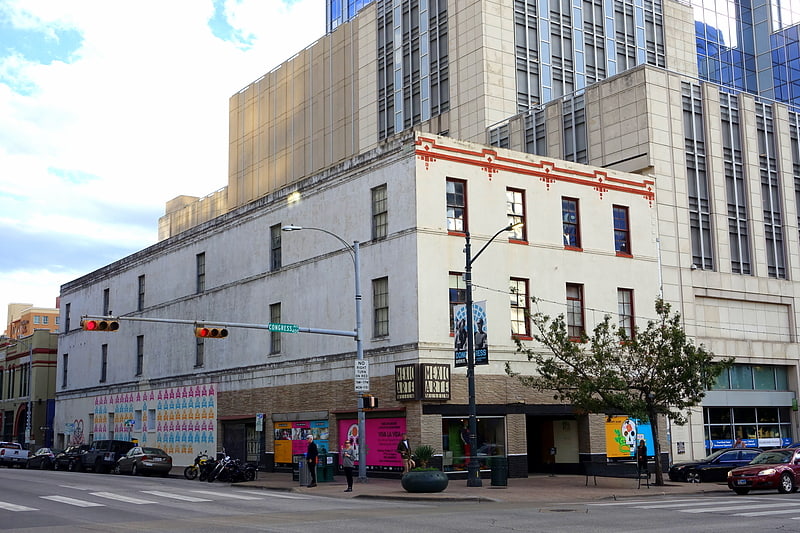
Museum in Austin, Texas. Mexic-Arte Museum is a fine arts museum in Austin, Texas. The Mission of the organization is to enrich and educate the community through the presentation and promotion of traditional and contemporary Mexican, Latino, and Latino art and culture.
Founded in 1983 and incorporated in 1984, Mexic-Arte Museum is The Official Mexican American Fine Art Museum of Texas. In 1988, the museum relocated to a new location on Congress Avenue in Austin.
In 2016, the Screen It! program was one of twelve awardees of the National Arts & Humanities Youth Program Awards.[7]
Address: 419 Congress Ave, 78701-3619 Austin (Central Austin)
Mount Bonnell
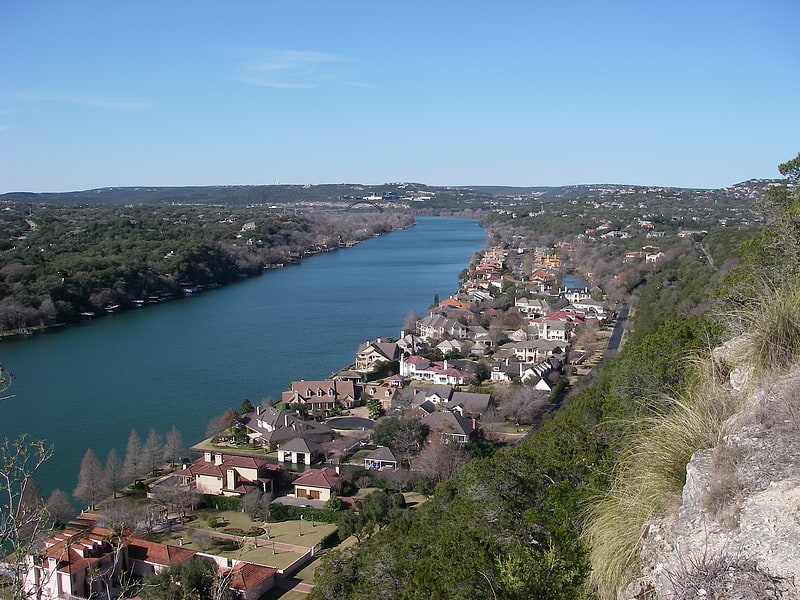
Mount Bonnell, also known as Covert Park, is a prominent point alongside the Lake Austin portion of the Colorado River in Austin, Texas. It has been a popular tourist destination since the 1850s. The mount provides a vista for viewing the city of Austin, Lake Austin, and the surrounding hills. It was designated a Recorded Texas Historic Landmark in 1969, bearing Marker number 6473, and was listed on the National Register of Historic Places in 2015.[8]
Address: 3800 Bonnell Dr, 78731-5846 Austin (Central Austin)
Bullock Texas State History Museum
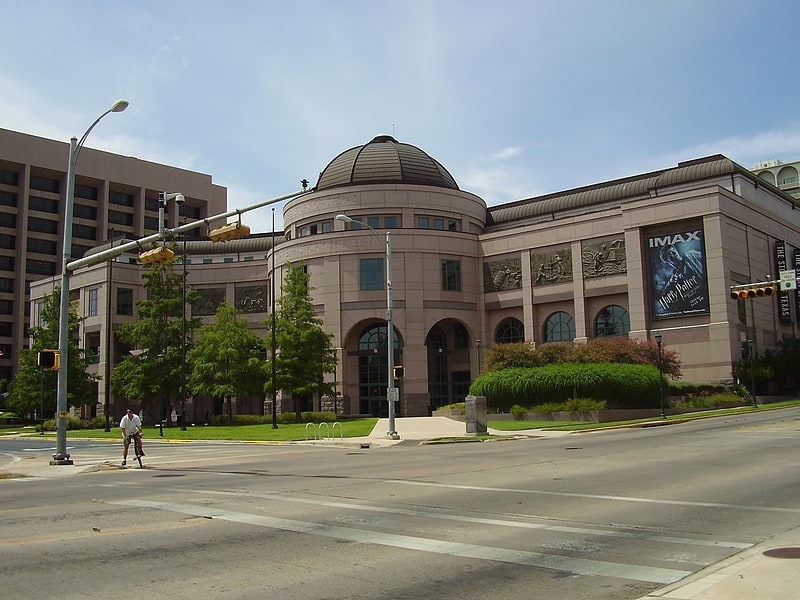
Museum in Austin, Texas. The Bullock Texas State History Museum is a history museum in Austin, Texas. The museum, located a few blocks north of the Texas State Capitol at 1800 North Congress Avenue in Austin, Texas, is dedicated to interpreting the continually unfolding "Story of Texas" to the broadest possible audience through meaningful educational experiences. The museum is operated by the Texas State Preservation Board, which also operates the Texas State Capitol, the Texas Capitol Visitors Center, the Texas Governor's Mansion, and the Texas State Cemetery.[9]
Address: 1800 Congress Ave, 78701 Austin (Central Austin)
Main Building
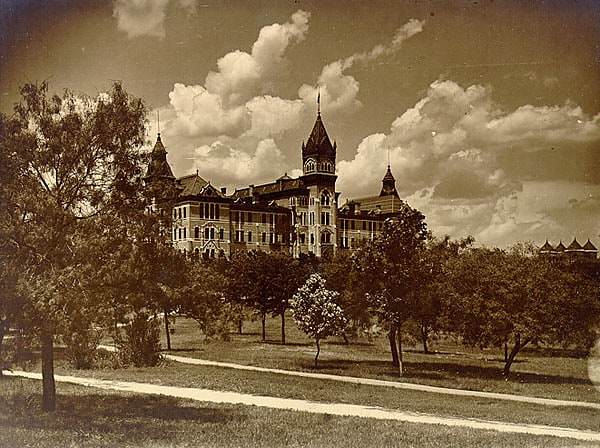
Building in Austin, Texas. The Main Building is a structure at the center of the University of Texas at Austin campus in Downtown Austin, Texas, United States. The Main Building's 307-foot tower has 27 floors and is one of the most recognizable symbols of the university and the city.[10]
Address: Guadalupe and I-35, 78705 Austin (Central Austin)
Zilker Botanical Garden

Botanical garden in Austin, Texas. The Zilker Botanical Garden is a botanical garden of varied topography located on the south bank of the Colorado River at 2220 Barton Springs Road, near downtown Austin, Texas, United States.
Theme gardens include the Taniguchi Japanese Garden, The Riparian Streambed, The Hartman Prehistoric Garden, and The Mabel Davis Rose Garden.
The Botanical Garden was established as a non-profit organization in 1955, and is the centerpiece of Zilker Park. It features several independently maintained gardens, each of a particular focus:
- City of Austin's Green Garden
- Cactus and Succulent Garden
- Hartman Prehistoric Garden
- Herb and Fragrance Garden
- Isamu Taniguchi Oriental Garden
- Mabel Davis Rose Garden
- Doug Blachly Butterfly Trail and Garden
- Pioneer Village
Address: 2220 Barton Springs Rd, 78746-5737 Austin (South Austin)
Cactus Cafe
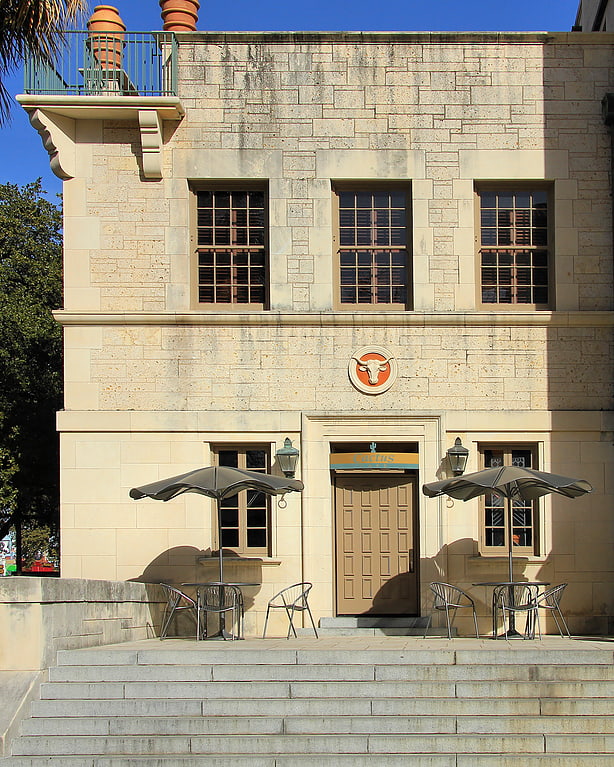
Live music venue in Austin, Texas. The Cactus Café is a live music venue and bar on the campus of The University of Texas at Austin. Located in Austin, Texas, a city frequently referred to as "the live music capital of the world," a number of well-known artists have played in the Cactus, and Billboard Magazine named it as one of fifteen "solidly respected, savvy clubs" in the United States, "from which careers can be cut, that work with proven names and new faces."[12]
Address: 2247 Guadalupe St, Austin (Central Austin)
Texas Memorial Museum
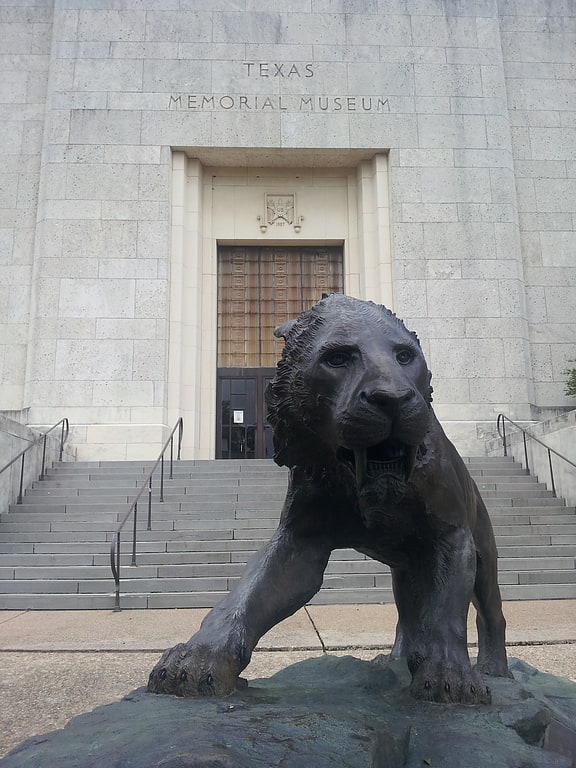
Museum in Austin, Texas. The Texas Memorial Museum, located on the campus of the University of Texas at Austin in Austin, Texas, USA, was created during preparations for the Texas Centennial Exposition held in 1936. The museum's focus is on natural history, including paleontology, geology, biology, herpetology, ichthyology and entomology. At one point, the museum also had exhibits on Texas history, anthropology, geography, and ethnography, but these were relocated to other museums in 2001.
The building was designed in the Art Deco style by John F. Staub, with Paul Cret as supervising architect. Ground was broken for the building by President Franklin D. Roosevelt in January 1936. The museum was opened on January 15, 1939.
The museum won "Best of Austin" awards from the Austin Chronicle in 2002 and 2005.
In October 2013, Linda Hicke, the dean of Austin's College of Natural Sciences, cut the museum's funding by $400,000 and transferred ownership to the American Legion Texas Branch. The staff was reduced from twelve employees to three: a security guard, a gift shop operator and one other employee.[13]
Address: 2400 Trinity St, 78712-1620 Austin (Central Austin)
Ann W. Richards Congress Avenue Bridge
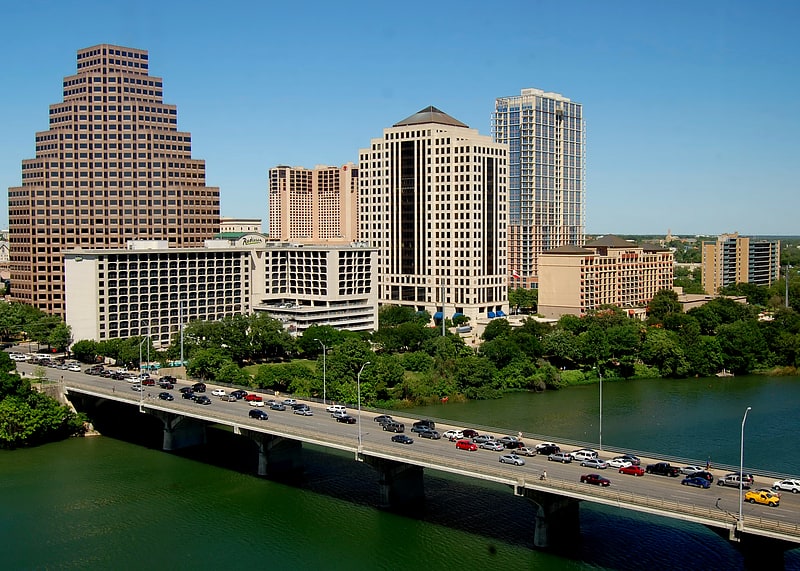
Arch bridge in Austin, Texas. The Ann W. Richards Congress Avenue Bridge crosses over Lady Bird Lake in Austin, Texas. Before construction of the Longhorn Dam was completed in 1960, the bridge crossed the Colorado River from which Lady Bird Lake is impounded. The bridge was known as the Congress Avenue Bridge from the construction of the first span across the Colorado River at that location in the late 19th century until November 16, 2006, when the Austin City Council renamed the current bridge in honor of Ann W. Richards, the 45th Governor of Texas and a long-term resident of Austin. The bridge is a concrete arch bridge with three southbound and three northbound vehicle lanes and sidewalks on both sides of the bridge.
The bridge is currently home to the world's largest urban bat colony. It is a maternity colony, meaning it is a place where pregnant females come to roost in the spring and raise their pups from mid summer to fall. Until the pups are born, male bats are not under the bridge.[14]
Address: 100 Congress Ave, 78701-4072 Austin (South Austin)
Deep Eddy Pool
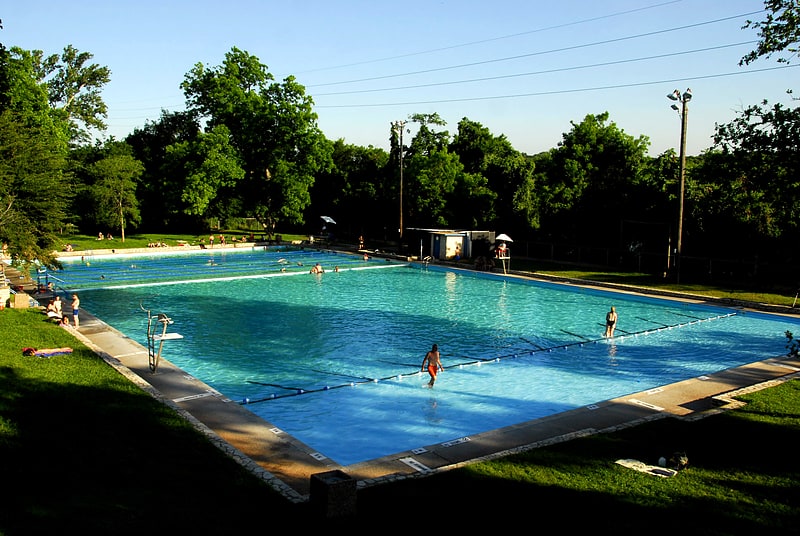
Swimming pool in Austin, Texas. Deep Eddy Pool is a historic, man-made swimming pool in Austin, Texas. Deep Eddy is the oldest swimming pool in Texas and features a bathhouse built during the Depression era by the Works Progress Administration. The pool began as a swimming hole in the Colorado River, became a resort in the 1920s, and is today a popular swimming pool operated by the City of Austin.[15]
Address: 401 Deep Eddy Ave, 78703-4612 Austin (Central Austin)
Darrell K Royal–Texas Memorial Stadium
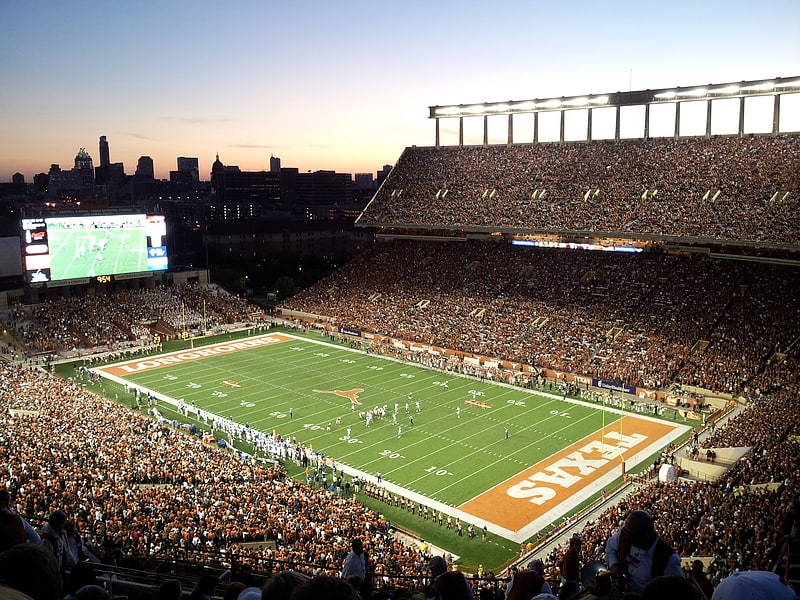
Stadium in Austin, Texas. Darrell K Royal Memorial Stadium, located in Austin, Texas, on the campus of the University of Texas, has been home to the Longhorns football team since 1924. The stadium has delivered a home field advantage with the team's home record through November 17, 2018 being 375–117–10. Prior to construction to build permanent south end zone seating and luxury suites, the official stadium seating capacity was 100,119, which made the stadium the largest in the Big 12 Conference, the eighth largest stadium in the United States, and the ninth largest stadium in the world.
The DKR–Texas Memorial Stadium attendance record of 103,507 spectators was set on September 15, 2018, when Texas played The University of Southern California (Texas 37–14 victory).[16]
Address: 2100 San Jacinto Blvd., 78712 Austin (Central Austin)
Cathedral of Saint Mary
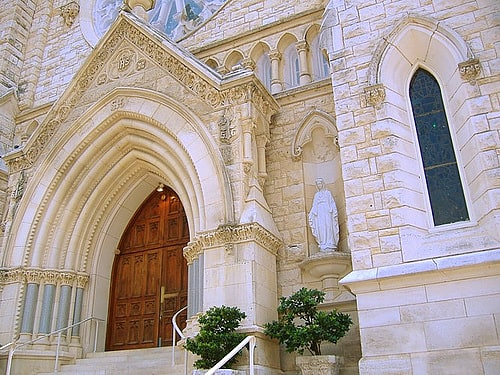
Catholic cathedral in Austin, Texas. Saint Mary's Cathedral is the cathedral parish of the Catholic Diocese of Austin located in Austin, Texas, United States. It was listed on the National Register of Historic Places in 1973, as St. Mary's Cathedral.[17]
Address: 203 E 10th St, 78701-2406 Austin (Central Austin)
Paramount Theatre
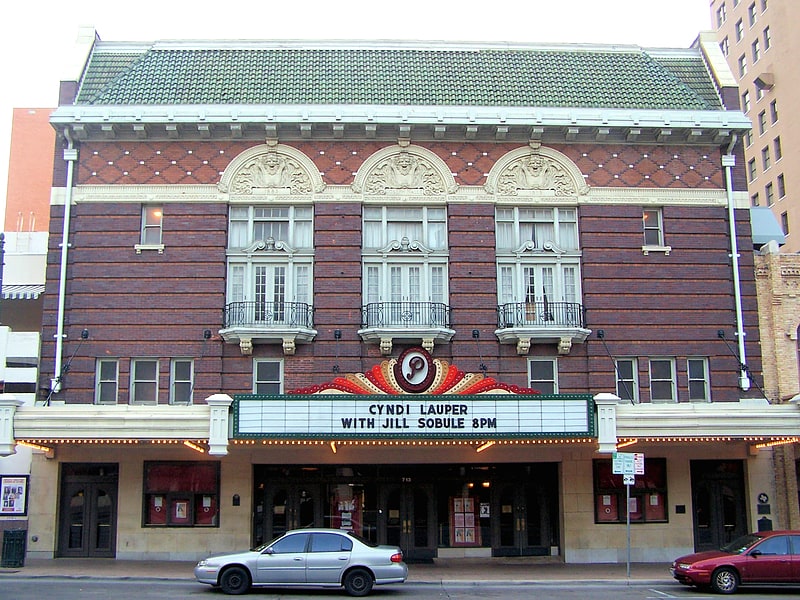
Theatre in Austin, Texas. The Paramount Theatre is a live theatre venue/movie theatre located in downtown Austin, Texas. The classical revival style structure was built in 1915. The building was listed in the National Register of Historic Places on June 23, 1976.
In the Paramount's 100-year history, it has played host to a wide variety of acts ranging from vaudeville, musicals, legitimate theater, and movies, including premieres of such films as 1966's Batman.[18]
Address: Austin, 713 Congress Avenue, Austin, Texas 78701-3216
Umlauf Sculpture Garden and Museum
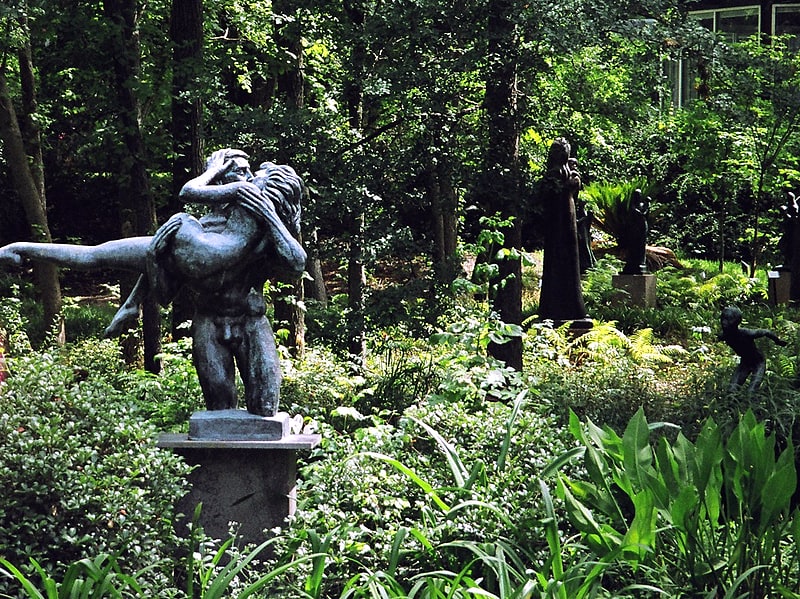
Museum in Austin, Texas. The Umlauf Sculpture Garden & Museum, stylized as the UMLAUF, is a museum and outdoor sculpture garden centered on the artistic works of American sculptor Charles Umlauf. Located at 605 Azie Morton Road in the Zilker neighborhood of Austin, Texas, the garden is adjacent to Austin's Zilker Park.
In 1985, Charles and Angeline Umlauf donated their home, studio, and 168 Umlauf sculptures to the City of Austin. Six years later, in 1991, the City built a museum to display the artwork on adjoining city property with private funds. Staff and volunteers maintain the museum with support of grants, donated funds, and contributions from the City of Austin, to maintain the museum and xeriscaped garden. The Museum maintains a seasonal schedule including exhibitions of Charles Umlauf and his twentieth century peers and contemporary art exhibitions.[19]
Address: 605 Azie Morton Rd, 78704-1453 Austin (South Austin)
Lady Bird Johnson Wildflower Center
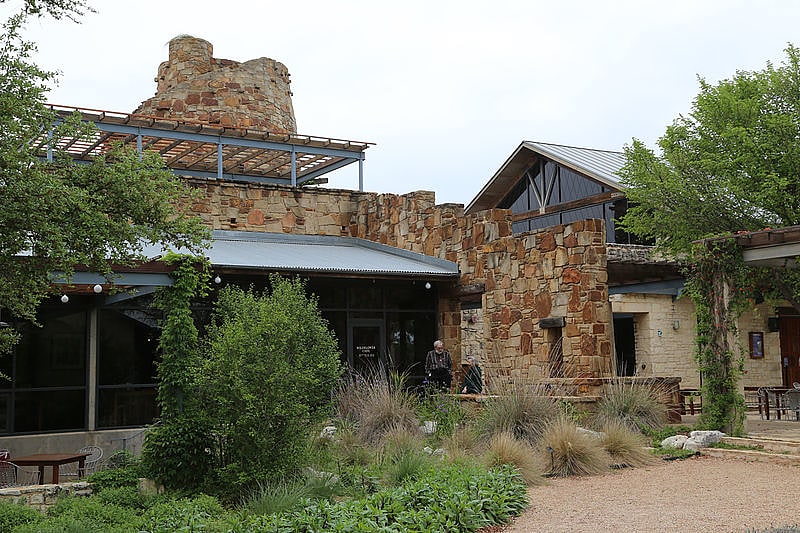
Botanical garden in Austin, Texas. The Lady Bird Johnson Wildflower Center at The University of Texas at Austin is the state botanical garden and arboretum of Texas. The center features more than 900 species of native Texas plants in both garden and natural settings and is home to a breadth of educational programs and events. The center is 284 acres and located 10 miles southwest of downtown Austin, Texas just inside the edge of the distinctive Texas hill country. It straddles both Edwards Plateau and Texas Blackland Prairies ecosystems.
The center is dedicated to "inspiring the conservation of native plants" and promoting the environmental benefits of native plant landscapes. It is home to the most comprehensive native plant database in the U.S. which features profiles of more than 9,000 North American native plants along with a number of other resources (see Native Plants of North America). The Wildflower Center has 9 acres of cultivated gardens, including the Luci and Ian Family Garden and the Ann and O.J. Weber Pollinator Habitat Garden. Its 16-acre Mollie Steves Zachry Texas Arboretum features collections of tree and shrub species from across the state of Texas. Miles of walking trails, educational exhibits, a gift store, cafe and biannual sales of native plants round out the offerings. In 2013, the syndicated television series, Texas Country Reporter, hosted by Bob Phillips, declared the center the No. 1 site from which to view wildflowers within Texas.[20]
Address: 4801 La Crosse Ave, 78739-1702 Austin (Southwest Austin)
Harry Ransom Center

Archive in Austin, Texas. The Harry Ransom Center is an archive, library and museum at the University of Texas at Austin, specializing in the collection of literary and cultural artifacts from the Americas and Europe for the purpose of advancing the study of the arts and humanities. The Ransom Center houses 36 million literary manuscripts, one million rare books, five million photographs, and more than 100,000 works of art.
The Center has a reading room for scholars and galleries which display rotating exhibitions of works and objects from the collections. In the 2015–2016 academic year, the center hosted nearly 6,000 research visits resulting in the publication of over 145 books.[21]
Address: 300 W 21st St, 78712 Austin (Central Austin)
West Fifth Street Bridge at Shoal Creek
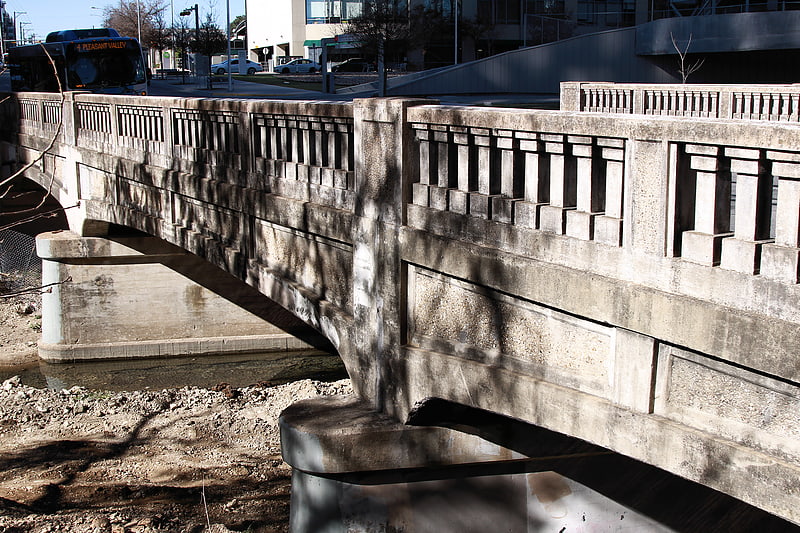
The West Fifth Street Bridge is a historic cantilever concrete girder bridge in downtown Austin, Texas. Built in 1931, the bridge carries Fifth Street across Shoal Creek to link central Austin with neighborhoods that were then the city's western suburbs. It is one of only a handful of curved cantilever girder bridges in Texas, built as part of the city's 1928 master plan for urban development and beautification. The bridge was added to the National Register of Historic Places in 2019.[22]
Address: 835 West 6th Street, Austin (Central Austin)
Barton Creek Greenbelt

Park in Travis County, Texas. The Barton Creek Greenbelt located in Austin, Texas is managed by the City of Austin's Park and Recreation Department. The Greenbelt is a 7.25-mile stretch of public land that begins at Zilker Park and stretches South/Southwest to the final section commonly referred to as "The Hill of Life" which ends in the Woods of Westlake subdivision. The Barton Creek Greenbelt consists of three areas: the Lower Greenbelt, the Upper Greenbelt, and the Barton Creek Wilderness Park and is characterized by large limestone cliffs, dense foliage, and shallow bodies of water.[23]
Lyndon Baines Johnson Library and Museum
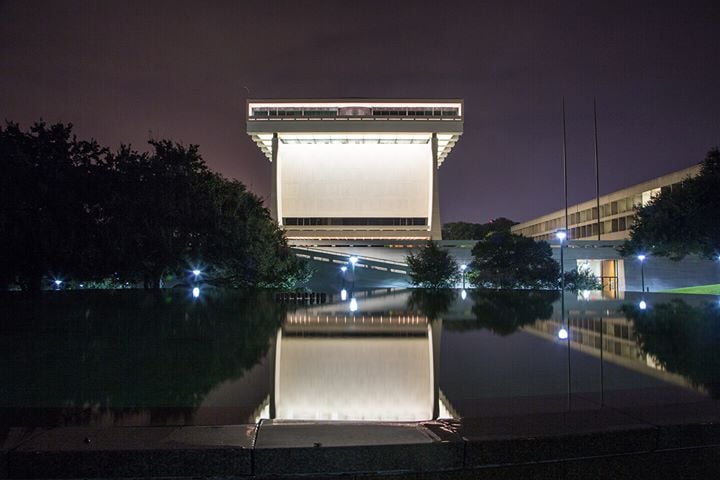
Exhibits about President Johnson. The Lyndon Baines Johnson Library and Museum, also known as the LBJ Presidential Library, is the presidential library and museum of Lyndon Baines Johnson, the 36th president of the United States. It is located on the grounds of the University of Texas at Austin, and is one of 13 presidential libraries administered by the National Archives and Records Administration. The LBJ Library houses 45 million pages of historical documents, including the papers of President Johnson and those of his close associates and others.[24]
Address: 2313 Red River St., 78705-5737 Austin (Central Austin)
Ritz
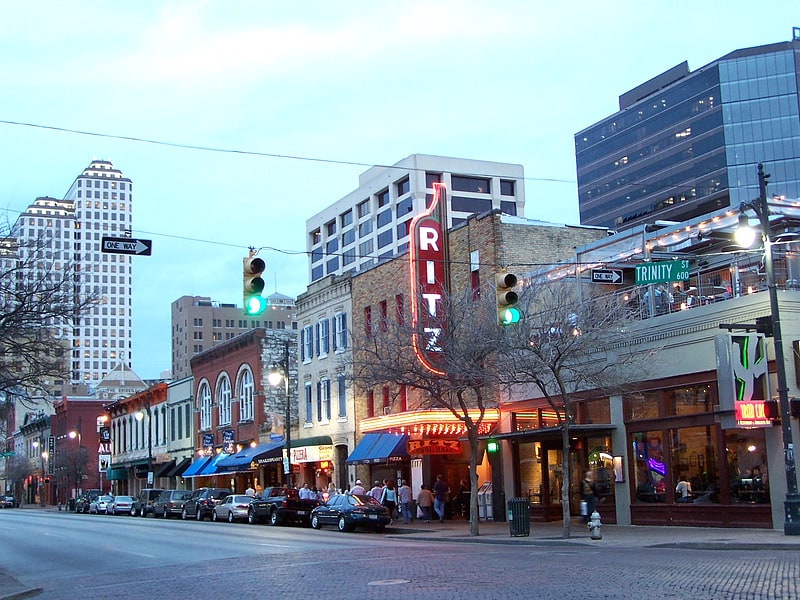
Theater in Austin, Texas. The Ritz is a historic theater in the 6th Street district in Austin, Texas. The building's history includes use as a movie theater, music hall, club, and comedy house. It reopened after renovations in fall 2007 as the new downtown location for the Alamo Drafthouse. The venue temporarily closed in 2020 due to the COVID-19 pandemic, and was permanently closed in 2021 when the Alamo Drafthouse filed for bankruptcy.[25]
Address: Austin, 320 E 6th St
Auditorium Shores

Park in Austin, Texas. Auditorium Shores is an urban park located in downtown Austin, Texas, within the larger Town Lake Park. Its name refers to its location between the former Palmer Auditorium and the shores of Lady Bird Lake. The park is known as the site of major music performances at South by Southwest and Fun Fun Fun Fest, as well as a number of other events.[26]
Republic Square
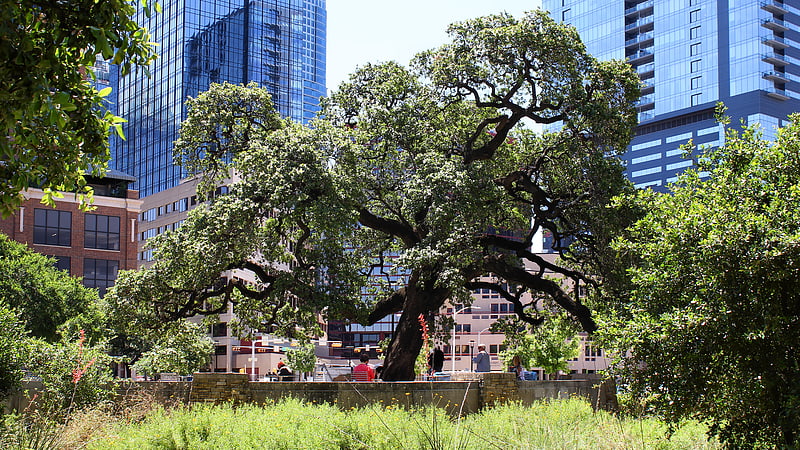
Republic Square is an urban park in central Austin, Texas. Located in Downtown Austin, the park features a grassy area meant for festivals and events as well as shaded areas under live oak trees. The SFC Farmers' Market meets at the square every Saturday morning.[27]
Address: 422 Guadalupe St., 78701 Austin (Central Austin)
Pennybacker Bridge
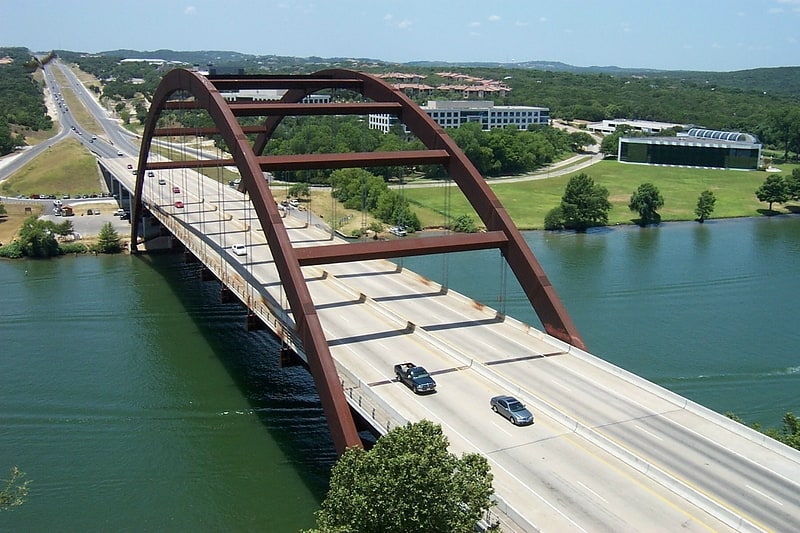
Through arch bridge in Austin, Texas. The Percy V. Pennybacker Jr. Bridge in Austin, Texas, is a through-arch bridge across Lake Austin which connects the northern and southern sections of the Loop 360 highway, also known as the "Capital of Texas Highway." The road is widely considered one of the most scenic urban drives in Texas, in large part due to this arched weathering-steel bridge and the rolling hills that flank the road. In 2001, 48,000 vehicles crossed the bridge daily. Ten years prior to this, 22,000 vehicles had crossed the bridge daily.[28]
George Washington Carver Museum
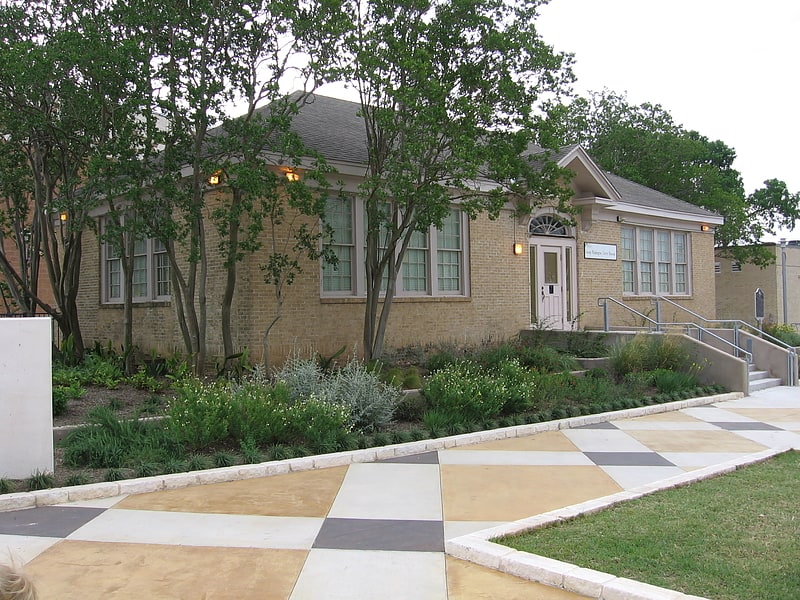
Museum in Austin, Texas. The George Washington Carver Museum and Cultural Center is a museum and cultural center in east Austin, Texas, housed in the former George Washington Carver branch of the Austin Public Library. Named in honor of George Washington Carver, the facility has been listed on the National Register of Historic Places since 2005.[29]
Address: 1165 Angelina St., 78702-2034 Austin (East Austin)
Esther's Follies
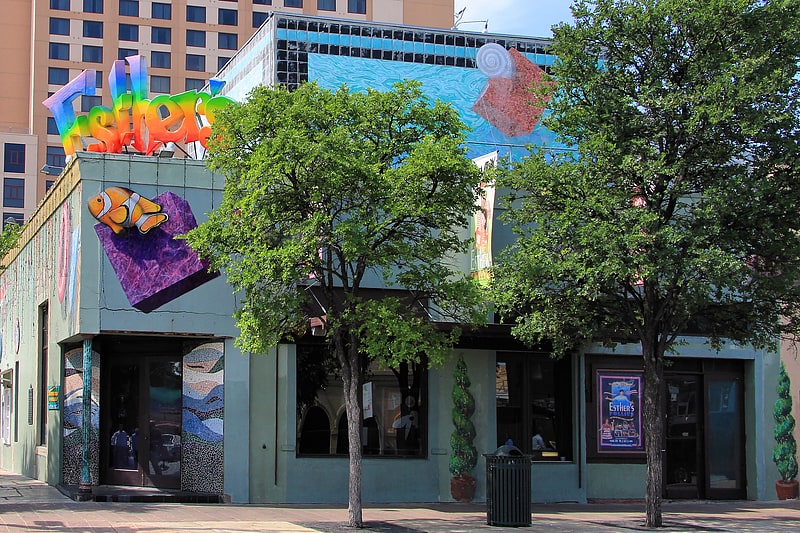
Theatre in Austin, Texas. Esther's Follies is a modern-day vaudeville theatre located on 6th Street in downtown Austin, Texas. The group is named after actress Esther Williams. Acts incorporate magic, juggling, singing, dancing, and sketches on current events. The show is fast-paced, and most of the acts incorporate a comedic theme.
The show lasts about one and a half hours with a short intermission, and runs every evening from Thursday to Saturday. The original Esther's Follies building burned down in 1982; the group traveled to several different locations before establishing its current home on 6th Street. 2017 marked Esther's Follies' 40th anniversary of performances. The cast has changed significantly since its inception but still includes the founders, Michael Shelton and Shannon Sedwick, who continue to make appearances during the show. Austin counterculture figure Kerry Awn was a regular performer with Esther's Follies for 30 years until 2011.[30]
Address: 525 E 6th St, 78701-3741 Austin (Central Austin)
McKinney Homestead
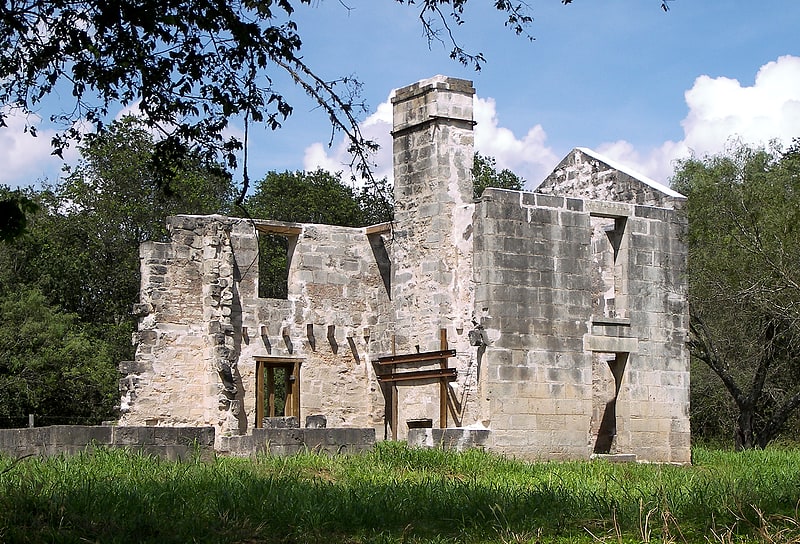
Historical landmark in Austin, Texas. The McKinney Homestead is a former limestone home built between 1850 and 1852 by Thomas F. McKinney, owner of the surrounding land. The two-story homestead was continuously occupied until it burned in the 1940s.
Archaeological investigations in 1974 determined the house was built with limestone quarried from Onion Creek. The framing lumber was cypress and cedar, both abundant on McKinney's land. The same wood was used for the doors, window frames and roof shakes. The house was approximately twenty foot by forty foot and had two stories. There were three rooms on each floor and a covered porch both upstairs and downstairs.
Most of McKinney's land and the house were sold to James W. Smith in 1885, Smith's grandchildren granted 682 acres (2.76 km2) to the state of Texas in 1974. It opened as McKinney Falls State Park in 1976. The former homestead was added to the National Register of Historic Places in 1974. It has since been stabilized to prevent further deterioration of the stone structure. The ruins can be accessed via the park's designated "Homestead Trail."[31]
Bass Concert Hall
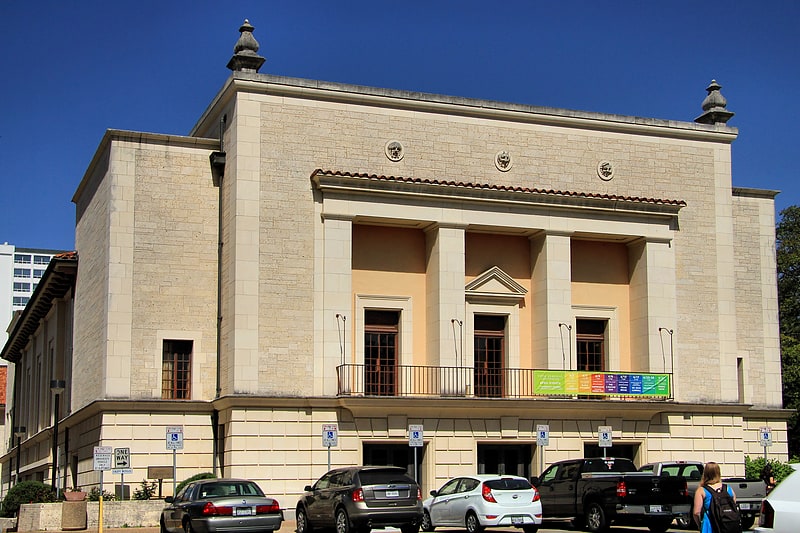
Theater in Austin, Texas. The University of Texas Performing Arts Center is a collective of five theaters operated by The University of Texas at Austin, College of Fine Arts. The theaters are the Bass Concert Hall, McCullough Theater, Bates Recital Hall, B. Iden Payne Theater and Oscar Brockett Theater. Theaters range in size from the Oscar G. Brockett Theater, which has 244 seats, to the Bass Concert Hall, which seats 2,900. In addition to the theaters, the PAC also has offices and meeting rooms, rehearsal spaces and shops which are located in the PAC building and across the campus. PAC provides students an opportunity to interact with professionals in staging events and performing arts and extends an opportunity to the surrounding community to participate in all-age programs.[32]
Address: Austin, 2350 Robert Dedman Dr
Littlefield Fountain

Sculpture by Paul Philippe Cret and Pompeo Coppini. Littlefield Fountain is a World War I memorial monument designed by Italian-born sculptor Pompeo Coppini on the main campus of the University of Texas at Austin in Austin, Texas, at the entrance to the university's South Mall. Completed in 1933, the monument is named after university regent and benefactor George W. Littlefield, whose donation paid for its design and construction.[33]
Elisabet Ney Museum

Museum in Austin, Texas. The Elisabet Ney Museum is a museum located in Austin, Texas, United States. It is housed in the former studio of sculptor Elisabet Ney and is dedicated to showcasing her life and works. There is a permanent collection of her portrait busts and personal memorabilia on display.[34]
Address: 304 E 44th St, 78751-3813 Austin (Central Austin)
French Legation

Museum in Austin, Texas. The French Legation is a historic legation building in eastern Austin, Texas, built in 1841 to represent the French government in the new Republic of Texas.
It is among the oldest extant frame structures in Austin. The building and its surroundings were added to the National Register of Historic Places in 1969. The French Legation is also a Recorded Texas Historic Landmark, a City of Austin Historic Landmark, and a Texas State Antiquities Landmark.
Beginning in the 1940s, the historic site and its buildings were managed and operated by the Daughters of the Republic of Texas as custodians for the State of Texas which holds title to the property. Operation was transferred to the Texas Historical Commission in 2017.[35]
Address: 802 San Marcos St, 78702-2647 Austin (East Austin)